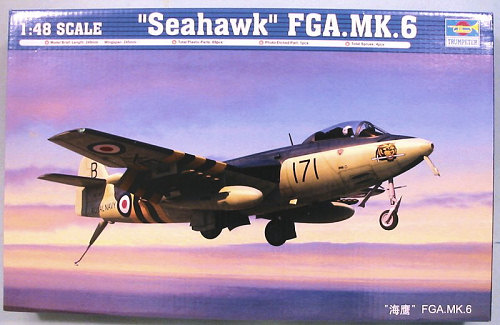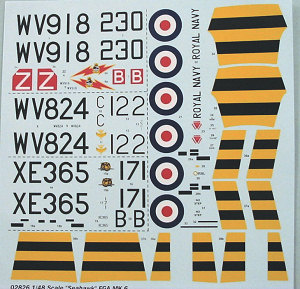
| KIT: | Trumpeter 1/48 Seahawk FGA.6 |
| KIT #: | ? |
| PRICE: | $44.98 MSRP |
| DECALS: | Three options |
| REVIEWER: | Tom Cleaver |
| NOTES: |

| HISTORY |
The Hawker Sea Hawk was the first completely successful British jet-powered carrier fighter. It was roughly equivalent to the U.S. Grumman F9F Panther, with which it shared a powerplant - the very successful Nene centrifugal turbojet - and of similar performance to the U.S. Navy's jet mainstay of the Korean War. While the Sea Hawk began its development process two years prior to the Panther, it first flew in the same year as the XF9F-2, and yet it entered service with the Fleet Air Arm in 1951, three years after the Panther had reached the same milestone. Even so, it was the most successful British jet of the to be developed in the immediate postwar period, a time marked by a strange technological lethargy in the British aviation industry.
The P.1040, as the Sea Hawk was initially know at Hawkers, began as a proposal for a single-engine jet fighter in the fall of 1944, which was not acted on until nearly a year later when it was rejected by the Air Ministry in favor of maximizing production of Meteors and Vampires. In January 1946, the design was proposed to the Admiralty as a carrier-based fighter; this resulted in an order in May 1946 for three prototypes, the first of which flew September 2, 1947 - within a few months of the XF9F-2 in the U.S.
The most original feature was the bifurcated engine exhaust, which neatly solved the problem of excessive loss of thrust associated with early turbojets when a longer exhaust pipe was used. While the casual observer might think the Sea Hawk was a twin-engine design like the McDonnell F2H Banshee, it had a single Nene at the center of gravity, which greatly aided its handling in flight. Pilots enjoyed the outstanding handling characteristics of the Sea Hawk, which were in direct opposition to the Supermarine Attacker, the other naval jet fighter under development at the time. Pilots particularly liked the fact the cockpit was as far forward as it was, giving good visibility for both combat and carrier landings.
The Sea Hawk F.Mk.1 was ordered into production in 1949. The outbreak of the Korean War gave added impetus to the need for the airplane, but Hawker was now deeply involved in the problems associated with creation of the Hunter. Production was shifted to Sir W. G. Armstrong Whitworth Aircraft, which had responsibility for further development and all production past the first 35 F.Mk.1s, the first of which flew November 14, 1951.
Service trials with the Hawker-built aircraft occupied most of 1952 while production hit its stride at Armstrong-Whitworth. 806 became the first operational Sea Hawk squadron in March 1953.
Following production of 60 Mk.1s, 40 F. Mk.2s appeared with powered controls. The demand for increased operational versatility was met with 116 F.B.Mk.3s which could carry bombs in place of the underwing drop tanks. The 97 FGA Mk.4s appeared with a "4 store" wing and the ability to carry rockets outboard of the pylons, but performance suffered. The Admiralty decided to upgrade the FB Mk.3s and FGA Mk.4s with the Nene 103, offering an increase in power from 5,000 to 5,200 lbs of thrust, to be known as the FGA Mk. 5 and Mk.6 respectively. Few were re-engined, but 87 new-build FGA Mk.6s were taken into service. When the last of these were delivered in January 1956, production of the Sea Hawk for the FAA came to an end. The FGA.6 was the first variant of the Sea Hawk to see combat action, providing close air support for the Anglo-Israeli-French Suez operation, Operation Musketeer, in November 1956.
| THE KIT |
 Previously, the Hawker Sea Hawk has been available in 1/48 scale in a vacuform
from Falcon first released in 1986, and a limited-run injection kit from Classic
Airframes released in 2004. This new kit from Trumpeter effectively makes these
other kits obsolete. The kit comprises 89 parts on four sprues of light grey
plastic and one of clear plastic, with decals for three aircraft, two flown
during Operation Musketeer and one flown from HMS Centaur in 1960 at the end of
the Sea Hawk’s career with the Royal Navy. The decals are sharp and printed in
register and look to be opaque enough to look good when applied. The black and
yellow “Suez stripes” are supplied as decals, which should please those who are
“stripe-o-phobic” when it comes to painting and masking these.
Previously, the Hawker Sea Hawk has been available in 1/48 scale in a vacuform
from Falcon first released in 1986, and a limited-run injection kit from Classic
Airframes released in 2004. This new kit from Trumpeter effectively makes these
other kits obsolete. The kit comprises 89 parts on four sprues of light grey
plastic and one of clear plastic, with decals for three aircraft, two flown
during Operation Musketeer and one flown from HMS Centaur in 1960 at the end of
the Sea Hawk’s career with the Royal Navy. The decals are sharp and printed in
register and look to be opaque enough to look good when applied. The black and
yellow “Suez stripes” are supplied as decals, which should please those who are
“stripe-o-phobic” when it comes to painting and masking these.
 Where both the Falcon
vacuform and the Classic Airframes limited-run kit had major fit issues, test
fitting of the parts in this kit shows no difficulty whatsoever with fit. The
surface detail is petite engraved panel lines, with no frickin’ rivets!
Interior detail is good. The cockpit is not highly detailed, but then it’s
going to be painted black so there won’t be that much to see anyway. The
injection-molded multi-part ejection seat looks better than the resin seat
provided by Classic Airframes. The internal detail for the wheel wells, intakes
and exhausts are very good.
Where both the Falcon
vacuform and the Classic Airframes limited-run kit had major fit issues, test
fitting of the parts in this kit shows no difficulty whatsoever with fit. The
surface detail is petite engraved panel lines, with no frickin’ rivets!
Interior detail is good. The cockpit is not highly detailed, but then it’s
going to be painted black so there won’t be that much to see anyway. The
injection-molded multi-part ejection seat looks better than the resin seat
provided by Classic Airframes. The internal detail for the wheel wells, intakes
and exhausts are very good.
The fuselage breaks down in the same way the other two kits are designed: the fuselage forward of the exhausts is divided horizontally, while the rear fuselage is split vertically. Unlike the other kits, the tail fits well to the forward fuselage along a panel line without difficulty.
The wings have the option of being displayed in the raised position. Additionally, the dive brakes and flaps may be posed deployed. Under wing ordnance includes 8 60-lb RPs and two drop tanks.
Weight will have to be supplied and installed around the cockpit tub and in the area of the forward fuselage forward of the wings.
| CONCLUSIONS |
This is the best kit yet released by Trumpeter. The mad riveter has been sent to some Chinese gulag to repent of his crimes, and the panel lines and overall crispness of molding establish this kit as being in the same class with any release from Tamiya or Hasegawa. the production design is excellent and portends an easy assembly, while fit looks like there won’t be a lot of filler being used. The canopy is a little thick, but can be posed open, and it has the right shape (which the Classic Airframes kit missed). Overall this is the best kit yet of this interesting and important Fleet Air Arm airplane, and fans of British naval aircraft will probably want more than one. Highly recommended.
Thanks to Stevens International for the review kit.
April 2007
If you would like your product reviewed fairly and quickly by a site that has over 350,000 visitors a month, please contact me or see other details in the Note to Contributors.